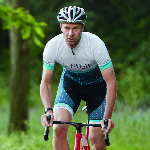
Nothing can clear your mind or get you fit faster than a tough bike ride. Sure, flats and downhills are fun—easy even, but it’s those uphill climbs that will really get your head and body into shape. So why do so many people complain about a grade change? They’re letting the thought of discomfort psych them out. Well, to those people I say, “Shut up legs!”
Of course, positive thinking isn’t the only thing that will get you up the hill. You still need to pedal! It will be simple and hard pedaling, but I do have some workout techniques to improve your climbing skills. Here’s what to do (and not do) the next time you’re faced with a set of killer rollers or switchbacks.
Don’t Get Intimidated
It’s only a hill and even something big and crazy hard—like Independence Pass leading out of Aspen, CO—will eventually come to an end. Instead of looking at the whole thing at once, mentally split the climb into smaller, more manageable portions.
Do Set Mid-Climb Mini Goals
I used to tell myself, “Ok Jens, hang in here until the next switchback,” or “I will stick with this group until that big tree on side of the road.” Creating mini-challenges for yourself is a great way to trick your brain that it’s not so bad and the suffering will end soon. (Of course, when you hit that goal, you’ve got to set another one until you get to the top.)
Don’t Anticipate the Pain
No, it’s not going to be comfortable, but saying (or worse, posting on social media), “OMG—there’s 45 minutes of pure pain and suffering ahead of me—and every minute will be worse than the last!” isn’t going to do you any good. With this kind of thinking, you are much more likely to give up. Don’t underestimate the mental part of cycling, a “never give up” attitude goes a very long way.
Do Maintain Consistent Output
Remember, your body works better when you hold a steady power output, speed is secondary. Speed varies with the profile, but in the ideal scenario you should aim to keep a constant watt or power output. Accelerating and then slowing down basically kills your performance—it stresses your body, making you feel tired more quickly.
Don’t Follow the Crowd
When I was racing, I often used to let everybody attack the climb like crazy—I’d let them get ahead of me and blow themselves up. By holding my output constant, in a power range I could sustain for 20 or 30 minutes, I was always able to catch most or all of them back after they reached their red zones too early. That’s key—on a climb you can only go into your red zone once, because you won’t have an opportunity to recover again until the downhill. It’s easier to recover from an all-out effort when it’s flat, but next to impossible to do so on a climb.
Do Train with Intervals
There is nothing more important than intervals for preparing your body for the change of rhythm which comes with racing—especially on hills. The more your body is able to handle a change of pedal rhythm, or a change in heart rate, the easier the climbing will be. I’m a big fan of 40/20 intervals. Here’s something to make you laugh: In my best years, I would 3 sets of 10 minutes of 40/20s—that’s half an hour of hurting myself! But it paid off for me, because at my size (77kg of bodyweight, and 1.90m in height) I’m not a natural born climber. I worked harder so that I could survive climbs that people thought would be out of my league.
Don’t Stand Up Too Soon
One last thing: Getting out of the saddle on an uphill will help you accelerate, but it will also make your heart rate jump up quickly. It’s best only to stand and pedal after a switchback, to help you regain speed and momentum.
Do Find Your Own Frequency
I know I said that was the last thing, but it’s not easy to shut Jensie up. I also want to mention pedal frequency. I always felt most comfortable and strong on a climb doing about 75 to 85 reps per minute. But that’s a personal thing—Chris Froome wins the Tour de France by doing 100 reps per minute on the uphill. It’s wise to listen to your body and stay in your comfort zone when it comes to pedal frequency.
Hopefully you’ll find these tips helpful for your own climbing and training. Let me know your thoughts in the conversation below.
This information is for educational purposes only and is not intended as a substitute for medical diagnosis or treatment. You should not use this information to diagnose or treat a health problem or condition. Always check with your doctor before changing your diet, altering your sleep habits, taking supplements, or starting a new fitness routine.

If you have questions about a Fitbit tracker, product availability, or the status of your order, contact our Support Team or search the Fitbit Community for answers.
Please note: Comments are moderated and may not appear immediately after submission.